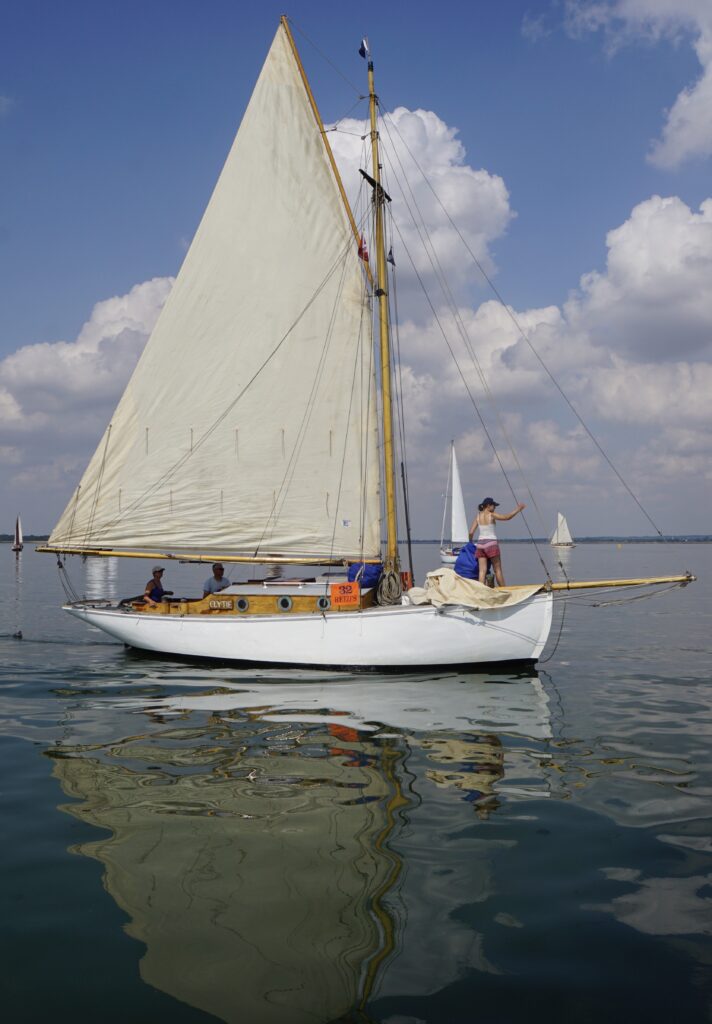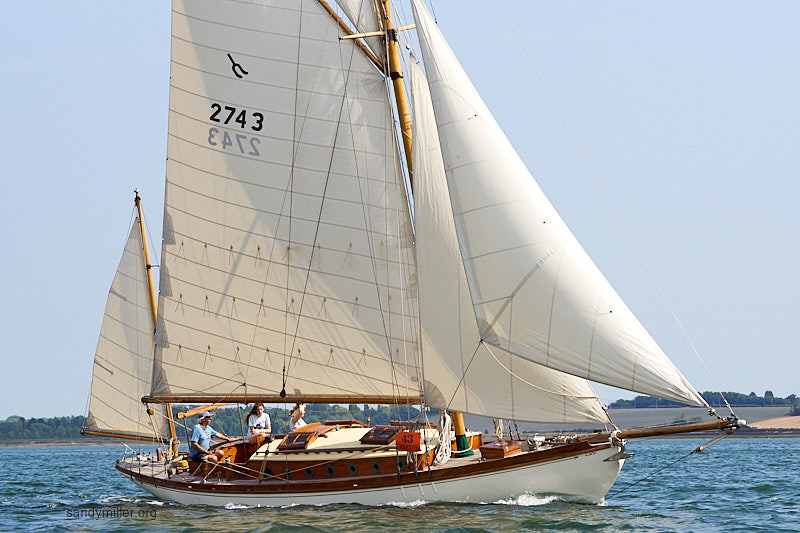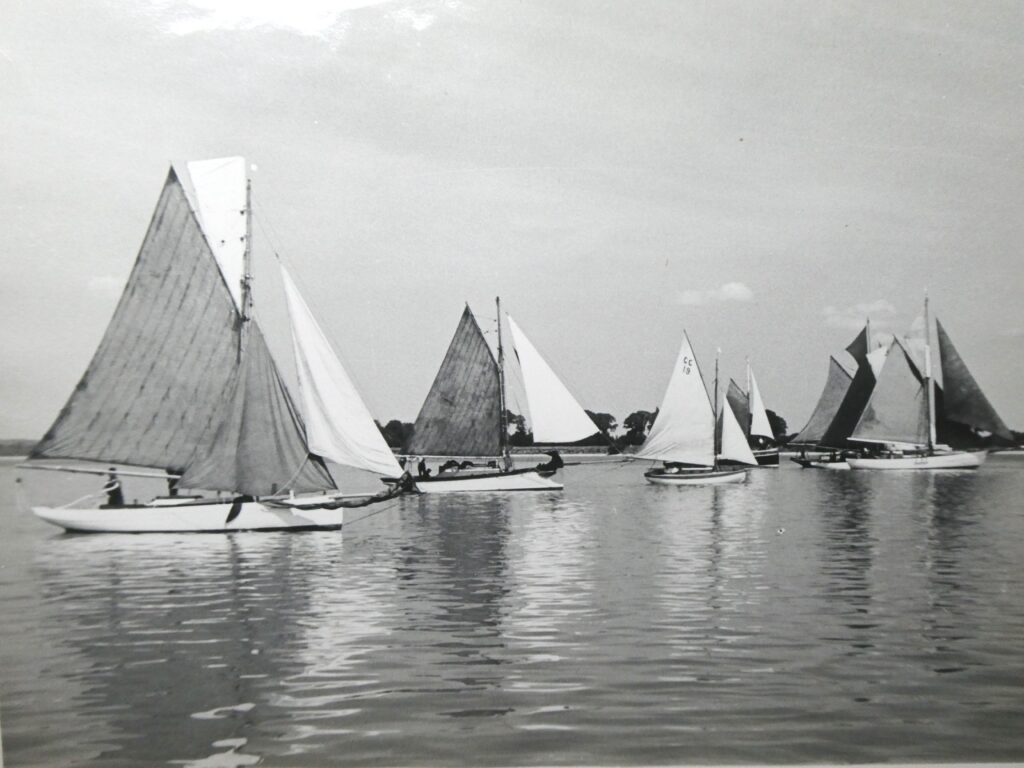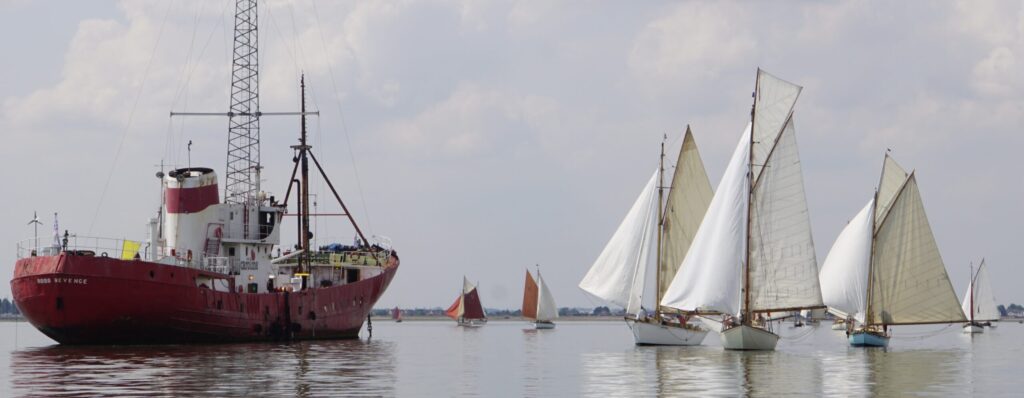OGA Boat Register Editor Alison Cable draws together highlights from the early days of the OGA East Coast Race, first run in 1963.
The first East Coast race was organised in 1963, inspired by races held in the Solent from the late 1950s. Three enthusiasts, John Bray, Roy Clarkson and John Scarlett, formed the first committee hoping to get a dozen entries. They were pleased to receive registrations from 27 boats, listed in the programme and 30 turned up on the start line. The planned course from Osea Island in the River Blackwater took the fleet up the Wallet to Harwich Harbour. This proved to be a mistake as the race started in a flat calm which turned to headwinds all the way. Only seven boats finished the course arriving much too late for the planned supper and party. However, it was agreed that Old Gaffer Races were a Good Thing and in September 1963 the OGA was formed with a commitment to running an Annual Race in each Area.
In 1964 a thunderstorm before the start left a near calm and fog through which the fleet of 33 boats drifted from Osea Island to the finish off East Mersea. The first three boats on corrected time won engraved pewter tankards while the Tom Bolton cup was awarded to the first fishing or ex-fishing boat to cross the finish line. Tom Bolton had taken part in the first race on his smack ‘Maria’ but was lost at sea in September 1963. His pals presented the cup in his memory and it is still awarded 60 years on. The weather was much better in 1965 with a brisk breeze. 40 boats had entered with the Race split into two classes due to the wide range of craft from 46’ to 17’. Apart from two accidents caused by carelessly handled spectator craft all went well. A new tradition was established with the winner of the Race becaming East Coast OGA Commodore until the next Race. The annual handing over of the Commodore’s pennant still happens. Another prize, the East Coast Old Gaffer’s Trophy awarded to the first boat over 50 years old on corrected time, also dates from 1965.










The field increased again in 1966 with 49 boats entered, split into three classes. The weather was good again but this time there was a more serious accident. One of the largest boats and a small boat collided in the narrows by the start forcing another rethink. In 1967 the start was moved to Stone, downriver from Osea Island. The Stone Sailing Club hosted and helped with arrangements. The start and finish were both at the Club and deemed to be an outstanding success. The ‘out and back’ course guaranteed a beat somewhere whichever way the wind blew and a record fleet of 56 boats enjoyed a fine day of sport with no incidents to spoil the fun. The next two years followed the same pattern with an ever increasing number of boats on the start line and in 1970 there were 80 entrants on the programme. Going by previous years more were expected on the start line but the weather put a stop to that. In a strong to gale force westerly only 15 boats were on the start line and only five finished.
During the 1970s the OGA East Coast Race went from strength to strength. 1971 saw 93 boats entered. The largest boat that year was ‘Solvig,’ a 70’ ex-Baltic trading ketch and the smallest was ‘Red Red Rose’ a 16’ lugger. 1979 saw innovations with the introduction of class V, for ‘very large vessels’ (over 50′ long) and the first award of the Titheridge Trophy, won by the first boat in class I or II sailed by husband and wife only. There were 107 entries in 1979 and numbers rose to 140 in the 1980s. Following a short period at Mersea in the 1990s, the race moved to Brightlingsea in 1999. From this time a wider range of courses are pre-planned so there will always be one that works on the day. Attendance had dropped from its peak but the Race still attracted 60 boats in an average year until the OGA50 Jubilee in 2013. In 2010 gales were forecast and rather than disappoint the large number of entries a course to Clacton and back was planned. A squall scattered the fleet on the way back and of the 40 boats starting only 24 finished. The following year a flat calm meant that when the tide turned some boats crossed the start line three times and the boats fastest to kedge gained seven places. In 2012 terrible weather conditions prevented many boats reaching the start line with only eight gaffers racing. The strong winds proved ideal for the 57’ ketch smack ‘Pioneer’. Her skipper was thrilled to win the OGA East Coast Trophy as his father had tried to win the cup for decades. ‘Pioneer’ had been chartered for the day to give Young Gaffers a chance to sail and it was good to see them do so well when many Old Old Gaffers staying ashore. The corresponding trophy for boats under 50 years old is the Stone Cup, won in 2012 by a boat at the other end of the fleet, the open cockpit Memory 19 ‘Letty May’.







The wind let us down for the 50th East Coast Race. We had worked hard to get as many boats from the first race to compete and exceeded expectations with ‘Fanny of Cowes’, ‘Fly’, ‘Maria’, ‘Kestrel’ and ‘Shoal Waters’ all racing. The wind died early and the classic Bermudans, last to start, got caught in the tidal gate in the Colne. The rest fought on up the Blackwater until the committee shortened the course in a somewhat unconventional way, which at least ensured that the 50th anniversary race would have a prizegiving. The East Coast Race continued to run annually from 2014 until the OGA60 Jubilee Race in 2023. The Race was cancelled in 2020 due to the Covid19 pandemic. This means that the 2024 Race is actually the 60th to be held since 1963.
Words and research from archives: Alison Cable, Boat Register Editor
Updated from a version first published in the OGA East Coast Race Programme, 2013
Which boats from our 60 year history are still sailing on the East Coast?
Please contact the Editor if you can help to update this list.
‘Red Red Rose’ may sail again in 2024 after lying in a shed since the late 1980s and undergoing a thorough restoration by Pete Thomas this year.
’Fanny of Cowes’, our featured boat in July 2023 was built in 1872 and won the first OGA East Coast Race in 1963. She still sails on the East Coast.
‘Shoal Waters’ was brand new in 1963, built by the late Charles Stock around a Fairey Falcon hot moulded hull with the spars and sails from his old boat ‘Zephyr’. She won the 1964 race and her skipper was awarded the 2009 Royal Cruising Club Medal for Services to Cruising, not least for his 1977 season when ‘Shoal Waters’ sailed 3307 miles including the East Coast Race. She’s still sailing on the English East Coast.
‘Kestrel’ is another Cowes built boat, believed to date from 1891. She was in a sorry state as she crossed the start line for the Race in 1963. Leaking badly she failed to finish. Sheathed in glass fibre by a new owner, she raced again in 1968 but was no longer afloat by 1991. Her current owner rebuilt her between 1997 and 2001. She still sails on the East Coast from her base on the River Deben.

You must be logged in to post a comment.